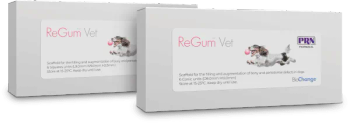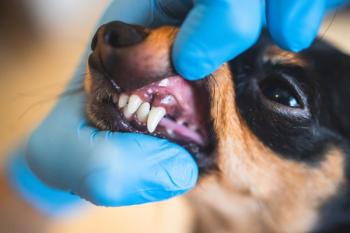
What are oronasal or oroantral fistulas?
Oronasal and oroantral fistulas are communications between the oral cavity and the respiratory tract.
The veterinary patient has a variety of health-care needs, and dental problems are common in both cats and dogs. Therefore, the annual physical exam should always include a complete oral examination. These routine evaluations along with a thorough history help veterinarians recognize potential problems. Oronasal and oroantral fistulas are communications between the oral cavity and the respiratory tract. The only difference is the location of these fistulas. The oronasal fistula is located more rostral (incisor, canine and premolar areas) compared to the oroantral fistulas which are situated in the caudal premolar and molar areas (Photo 1).
Photo 1: Notice the intact sutures (arrows) adjacent to an oronasal fistula as well as an oroantral fistula in the caudal premolar area.
What is the cause of oronasal or oroantral fistulas?
Oronasal fistulas are more common than oroantral fistulas in my experience. These lesions often appear as complications associated with dental extractions. To avoid these complications, all extraction sites should be closed using a well-designed mucogingival flap. These flaps need to be designed with maximal blood supply, epithelium- free edges and of adequate size to cover the underlying defect. The flaps should be sutured in a tension-free manner and preferably overlying bone. I prefer 4-0 Monocryl suture; however many suitable suture materials are available.
Periodontal disease is also a very common cause for oronasal or oroantral fistulas. Dachshunds are frequently affected. In these cases, deep palatal pockets (vertical bone loss) are often probed adjacent to the palatal aspect of the upper canine teeth. To avoid the development of these lesions, early recognition and appropriate periodontal therapy is required.
Other causes for communications between the oral cavity and the respiratory tract include foreign-body penetration, bite wounds and neoplasia. Inherited or developmental clefts of the lip or palate are also well-recognized causes of these defects. Each case must be precisely diagnosed and treated appropriately.
History and clinical presentations
In some cases, patients with oronasal or oroantral fistulas will present with obvious holes that communicate with the respiratory track. Debris is usually evident within these lesions. These defects may be associated with a previous dental extraction. For some patients the fistulas appear as a draining track in the incisive area (Photo 2) and the communication with the respiratory tract is not evident during the initial visual examination.
Photo 2: Draining track from the incisive area.
Patients with these types of oronasal or oroantral fistulas may present for evaluation of sporadic or chronic sneezing. Unilateral or bilateral nasal discharge may also be characteristic. Alternately, patients with oronasal fistulas may present with no historical or clinical signs. A comprehensive oral health assessment and treatment must always include meticulous periodontal probing in the anesthetized patient. Dental radiographs frequently do not demonstrate these lesions. Dachshunds are the most common breed presented for oronasal fistula repair in my practice however; the problem has been identified in a variety of cat and dog breeds.
Diagnose first, and then treat optimally
Recognition of the cause of these lesions is fundamental to treatment planning and repair. A systematic approach to the oral examination helps to avoid missing lesions and helps with optimal treatment planning.
For patients with deep palatal pockets adjacent to the upper canine teeth, the determination of communication between the oral and respiratory track is essential. If vertical bone loss does not communicate with the oral cavity, dental extraction or periodontal therapy may be the optimal treatment.
If an oronasal or oroantral fistula is confirmed, any product placed within these defects will migrate into the respiratory tract and act as an irritant.. Therefore, therapies directed at periodontal rejuvenation (root planing followed with perioceutics such as Doxirobe gel) or guided tissue regeneration (root planing with placement of bulk matrix barriers such as Consil or grafting materials such as Osteoallograft Periomix) cannot be utilized.
Diagnosis of fistulas
The clinician may irrigate the suspect lesion and observe the irrigant flow from the ipsilateral nostril. For additional confirmation, fluorescein dye can be infused into the defect with observation for the dye within or emerging from the ipsilateral nostril.
Dental radiography along with periodontal and dental probing should never be omitted. Dental radiographs allow for a general assessment of bone, soft tissues and teeth in the area of a suspect defect. These assessments help in treatment planning for repair of the fistula.
Treatment planning for repair of fistulas
Understanding the client's priorities is fundamental to treatment planning. Ideally, all oral fistulas communicating with the respiratory tract should be repaired. Clear explanations of the benefits and risks associated with repair are needed to obtain informed consent to proceed with treatment.
The size of the defect does matter. The appearance of the soft tissue lesion is typically much smaller than the underlying bony defect. Flap design must be based on the location and the size of the defect. Mucogingival flaps can be single or double layered. The single layer flap is useful in many cases, however the double flap repair can be particularly useful for chronic defects.
Mucogingival flaps must be designed to allow maximal blood supply (tissue perfusion). They must be of sufficient length and width (1.5 to 2 times the defect size) to be tension-free. The connective tissue of the flap must be opposed to connective tissue of the defect. The edges of the defect and the flap should be debrided free of granulation tissue and epithelium. Ideally, the flap should be sutured over healthy bone. The incidence of flap dehiscence is greatly reduced by following these principles; maximum perfusion, overlying bone and tension-free. Flap dehiscence is also minimized by evaluating for, and eliminating occlusal trauma. Clients should withhold hard food and chew toys from the patient for two weeks following surgery, and avoid manipulating the mouth when administering oral medications.
Summary
Oronasal and oroantral fistulas are communications between the oral cavity and the respiratory tract. These lesions can occur in both cats and dogs. The cause of these fistulas varies. They are commonly associated with advanced periodontal disease or as complications of dental extraction. Additionally, oronasal or oroantral fistulas can be a result of inherited or developmental defects as seen with a cleft lip or cleft palate. Foreign body penetration, neoplasia or trauma are also potential causes for these defects. Affected patients may or may not demonstrate clinical problems. However, patients that present with a history of chronic sneezing should be suspect for fistulas. Every dachshund should be evaluated regularly for oronasal fistulas using dental radiography and careful periodontal probing due to the particularly high incidence of oronasal fistulas in this breed.
Diagnosis must precede treatment planning for optimal patient care. Oronasal and oroantral fistulas should be treated because appropriate treatment can dramatically improve the quality of life for these animals.
Case 1:
Blackie, an 18-year old male domestic shorthaired cat, presented with reduced appetite for approximately three weeks and for having sneezing episodes after eating and drinking. Blackie seemed to be interested in food, but he would eat small amounts and run from the food dish. After each sneezing episode, Blackie rubbed his face and eyes. The client was worried about Blackie's quality of life and had considered euthanasia.
Laboratory and clinical findings:
> BUN 29 mg/dl and Creatinine 1.0 mg/dl.
> Electrolytes were within normal limits.
> ALT 100 U/L (normal reference range=12-130) and ALKP 22U/L (normal reference range=14-111).
> Totoal Thyroxine (TT4)4 2.7ug/dL (normal reference range=1.9-4.8).
> Heart rate 100 beats/minute.
> ECG and Doppler blood pressure were normal.
> Oral examination revealed an oral lesion (Photo 3).
Photo 3: Blackie's oral lesion.
> Dental radiographs demonstrate alveolar osteitis (Photo 4).
Photo 4: Alveolar osteitis.
> Periodontal probing was normal.
> Clinical photos with flap exposure demonstrate the soft tissue defect and the larger underlying bony defect (Photos 5, 6).
Photos 5 and 6: Note the soft-tissue defect and the underlying bony defect.
Diagnosis: Oronasal fistula was secondary to dental extraction.
Treatment plan: Mucogingival flap closure of oronasal defect.
Result: Blackie returned to normal eating and the flap healed very well (Photo 7).
Photo 7: Blackie's repaired and healed oronasal fistula.
Comment: The owners were pleased with the surgical repair of the oronasal fistula. They were grateful to their veterinarian for offering the referral. The dental consultation helped the owners better understand the diagnosis, prognosis and treatment plan.
Case 2:
Jabba, a 13-year-old dachshund with chronic periodontal disease and extreme halitosis. The owner had noted sneezing since Jabba was approximately three years old.
Laboratory and clinical findings:
> Blood work results were within normal limits.
> Oral examination revealed debris within a large oronasal fistula in the area of a previously extracted right upper canine tooth (Photo 8). The left side was similarly affected.
Photo 8: One of Jabba's large irregular lesions.
> Dental radiographs revealed bony changes at the defect (photo 9).
Photo 9: Radiograph of the bony defect.
> Periodontal probing penetrated deep into the respiratory tract.
Diagnosis: Oronasal fistula.
Treatment Plan: The bony defect was approximately 2.5 cm by 1 cm. To create a mucogingival flap closure, the adjacent premolar teeth were extracted. Notice the debris within the respiratory tract on the enhanced radiograph (Photo 10).
Photo 10: Note respiratory tract debris.
Treatment: A mucogingival flap closure was performed in two layers to repair fistulas. (Photos 11, 12).
Photos 11 and 12: A mucogingival flap closure was performed in two layers for each fistula.
Result: The surgical sites healed well. The owner reported that Jabba was eating better and had improved energy levels since the oronasal fistula repair.
Comment: Oronasal fistulas are particularly common in dachshunds.
Dr. Dale Kressin operates the Animal Dental Center in Oshkosh, Wis. He is a diplomate of the American Veterinary Dental College and provides a conforming residency recognized by the American Veterinary Dental College.
Newsletter
From exam room tips to practice management insights, get trusted veterinary news delivered straight to your inbox—subscribe to dvm360.






